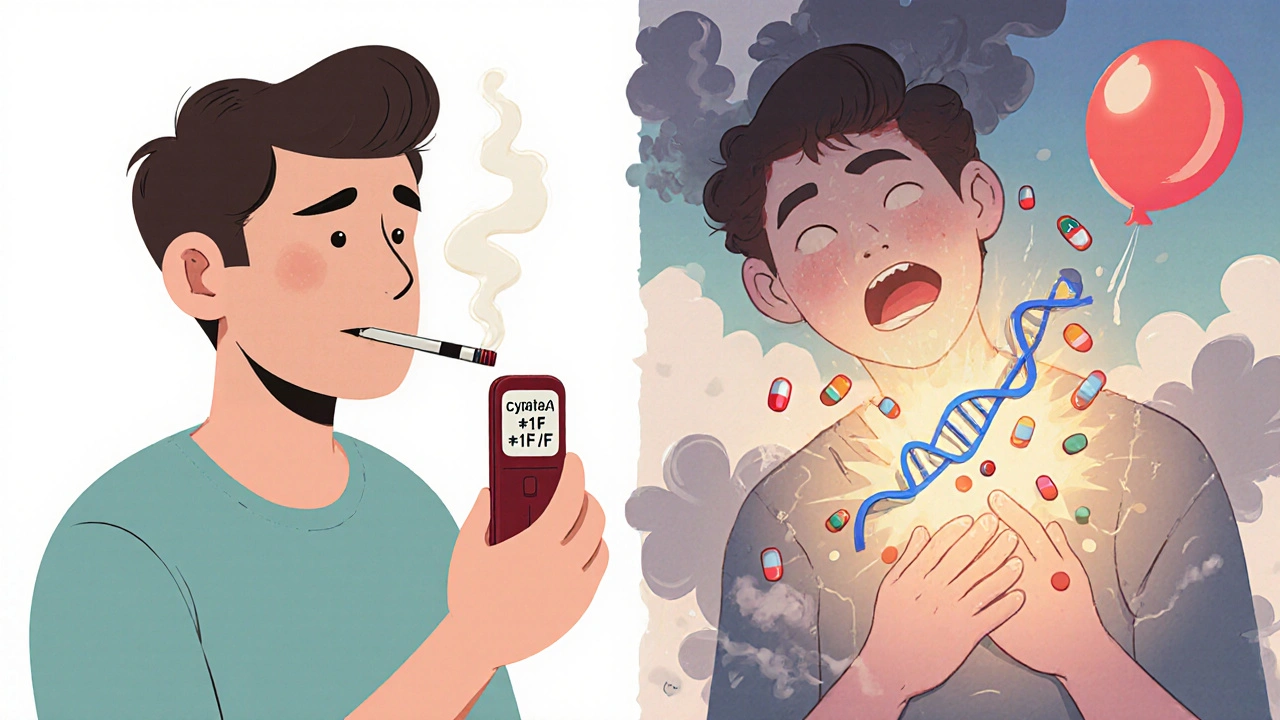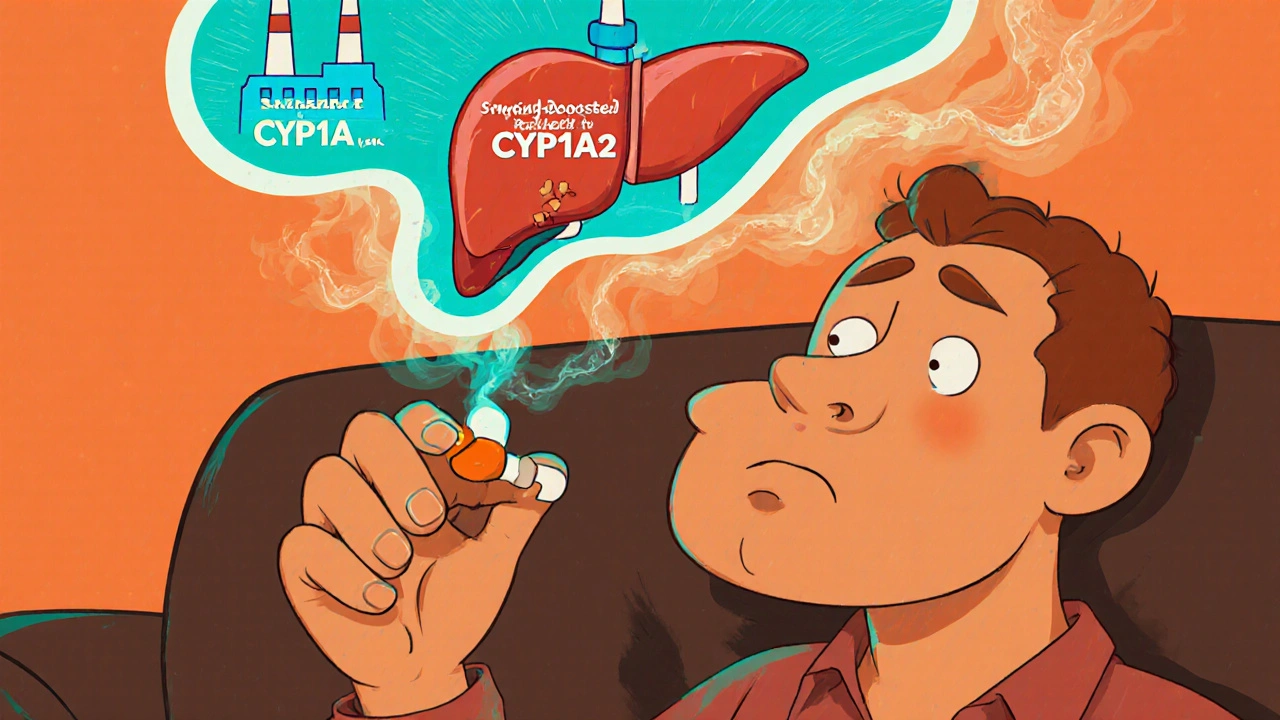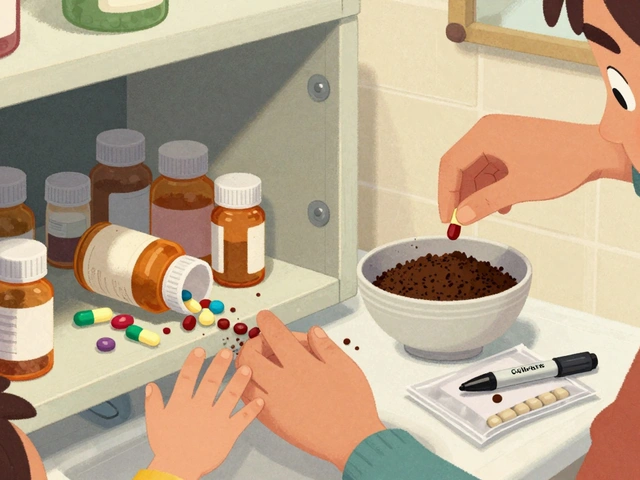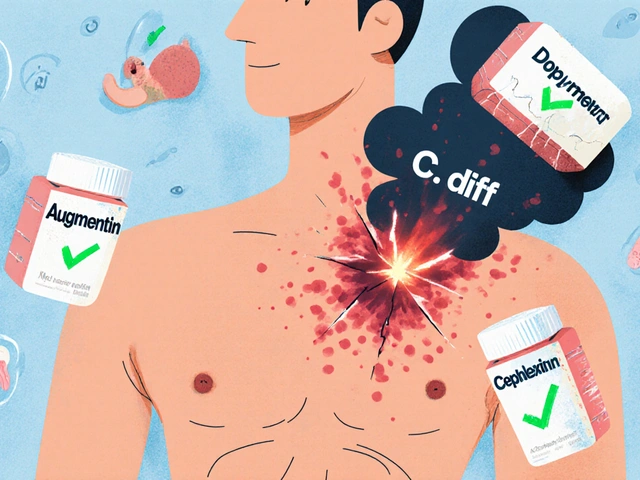Clozapine Dose Adjustment Calculator
Smokers on clozapine often have 30-50% lower blood levels than non-smokers. Quitting smoking without dose adjustment can cause toxicity. Your dose may need to change by 30-60% based on smoking status.
Why Your Clozapine Dose Might Not Be Working - Even If You’re Taking It Right
If you’re on clozapine and you smoke, your medication might be working at half strength - and you probably don’t even know it. Clozapine is one of the most powerful antipsychotics for treatment-resistant schizophrenia, but its effectiveness isn’t just about the pill you swallow. It’s also about what’s in your lungs. Tobacco smoke doesn’t just harm your lungs; it actively changes how your body processes clozapine, often dropping blood levels by 30% to 50%. That’s not a small tweak. That’s the difference between symptom control and a return to psychosis.
How Tobacco Smoke Turns Off Your Medication
Clozapine is broken down in your liver by an enzyme called CYP1A2. This enzyme is like a factory worker - it takes clozapine apart so your body can clear it. But when you smoke, chemicals in tobacco smoke - especially polycyclic aromatic hydrocarbons - tell your liver to make more of this enzyme. Suddenly, your CYP1A2 factory is running double shift. It’s breaking down clozapine faster than your doctor planned for.
This isn’t theoretical. Studies show that smokers on clozapine have, on average, 30% lower blood levels than non-smokers. In heavy smokers, levels can drop by up to 50%. That means if your target level is 400 ng/mL to stay stable, you might be sitting at 200 ng/mL - below the minimum needed to control symptoms. You might feel like your medication stopped working, but it’s not the drug. It’s your smoke.
What Happens When You Quit Smoking?
Here’s the flip side: quitting smoking can be just as dangerous as starting it - if you don’t adjust your dose. When you stop smoking, your liver doesn’t immediately slow down CYP1A2 production. It takes 1 to 2 weeks for enzyme levels to drop back to normal. During that time, clozapine builds up in your blood because the enzyme that used to clear it is now working at half speed.
That’s when toxicity hits. Symptoms include extreme drowsiness, rapid heartbeat, confusion, tremors, and in severe cases, seizures or heart inflammation. One case report described a woman who took 400 mg of clozapine daily for years. After quitting smoking, her levels spiked to 850 ng/mL - nearly double the safe range. She ended up in the hospital. Her dose had to be cut by 37.5% to get back to safety.
This isn’t rare. Psychiatrists report that 82% of them adjust clozapine doses when patients quit smoking. But many patients aren’t warned. They think quitting smoking is purely a health win - and it is - but without dose adjustment, it can become a medical emergency.
Why Clozapine Is Different From Other Antipsychotics
Not all antipsychotics are affected the same way. Olanzapine also goes through CYP1A2, but only about 30-40% of its clearance depends on it. Clozapine? Up to 70%. That’s why the drop in levels is so much sharper. Plus, clozapine has a narrow therapeutic window: 350-500 ng/mL. Go below 350, and symptoms return. Go above 500, and you risk toxicity.
Compare that to risperidone, which is cleared mostly by CYP2D6 - a different enzyme that tobacco smoke doesn’t affect. Or quetiapine, which relies on CYP3A4. Neither of those sees the same dramatic swings. That’s why clozapine is uniquely vulnerable. It’s not just the drug - it’s the perfect storm of metabolism, dose range, and environmental trigger.

Genetics Make It Even More Complicated
Not everyone responds the same way to smoking. Your genes matter. The CYP1A2 *1F/*1F genotype is common - about 20% of people have it. These individuals start with normal enzyme levels, but when they smoke, their bodies ramp up CYP1A2 more aggressively than others. So even if you’re a light smoker, if you have this genotype, your clozapine levels could crash faster than someone without it.
Some clinics now test for this gene variant. It’s not routine everywhere, but in specialized psychiatric programs, it’s becoming standard. If you’ve had trouble stabilizing on clozapine, and you smoke, asking for CYP1A2 genotyping might give you answers your doctor hasn’t considered.
What Clinicians Actually Do (And What You Should Expect)
Good psychiatrists don’t just write prescriptions. They track smoking status like vital signs. In one survey, 68% of psychiatrists check if their clozapine patients smoke at every visit. When someone starts smoking, they typically increase the dose by 40-60%. If someone quits, they drop it by 30-50% - and recheck blood levels within a week.
Here’s a real-world example: A patient on 300 mg daily has stable symptoms. Then they start smoking. Two weeks later, they’re hallucinating again. Their blood level is 180 ng/mL. Their dose is raised to 500 mg. A week later, it’s back to 420 ng/mL - back in range. Symptoms vanish.
On the flip side: a patient on 500 mg daily quits smoking. They feel fine for the first few days. Then they get dizzy, their heart races, they can’t stay awake. Their level is 780 ng/mL. Dose is cut to 275 mg. Within 10 days, they’re stable again.
These aren’t edge cases. They’re daily occurrences in clinics that treat treatment-resistant schizophrenia.
What About Vaping? Is It Safer?
Many patients think switching to e-cigarettes avoids the problem. It doesn’t. A 2024 study in Nature Communications found that vaping still induces CYP1A2 - just a little less than traditional cigarettes. About 15-20% less. So if you were smoking 20 cigarettes a day and switched to vaping, you might still need a 20-30% dose increase. Don’t assume vaping is safe for your clozapine levels. It’s not.

What You Can Do Right Now
- If you smoke: Tell your prescriber. Don’t wait for your next appointment. Ask for a clozapine blood level test. You might need a higher dose.
- If you’re trying to quit: Don’t quit cold turkey without talking to your doctor. Plan the quit date together. Expect to reduce your dose by 30-50% over the next two weeks. Get your levels checked at day 7 and day 14.
- If you’re not sure: Ask if your clinic does therapeutic drug monitoring. If they say no, ask why. This interaction is well-documented. Monitoring isn’t optional - it’s standard of care.
Why This Matters Beyond Just Dosing
Unmanaged clozapine-smoking interactions lead to more hospitalizations, more relapses, and more trauma. A 2021 study found that when this interaction isn’t handled properly, hospitalization rates jump by 22%. That’s over $14,500 per avoidable stay.
And it’s not just about money. It’s about dignity. People on clozapine are often told they’re non-compliant when their symptoms return. But if they’re smoking and their dose hasn’t been adjusted, they’re not non-compliant - they’re victims of a poorly communicated drug interaction.
There’s hope. New sustained-release clozapine formulations are being tested to smooth out these peaks and valleys. Electronic health records now flag smoking status automatically. Pharmacogenetic testing is becoming more common. But until these tools are universal, the simplest fix remains: talk to your doctor about smoking - and get your levels checked.
It’s Not About Quitting - It’s About Managing
You don’t have to quit smoking to stay stable on clozapine. But you do have to be honest about it. And you do have to work with your care team to adjust your dose. Many patients say their symptoms finally stabilized only after their doctor understood the smoking link. One Reddit user wrote: “I tried to quit three times. Each time, I ended up hospitalized. Then my doctor adjusted my dose. I’m stable now - and I still smoke. But I’m not sick.”
That’s the goal. Not perfection. Not abstinence. Stability. Safety. And that only happens when you treat smoking not as a moral failing, but as a pharmacological variable - just like your weight, your kidney function, or your other medications.






mike tallent
November 17, 2025 AT 09:13Get your levels checked. Seriously. Your brain deserves better than guesswork.
Joyce Genon
November 18, 2025 AT 04:19John Wayne
November 19, 2025 AT 16:34Julie Roe
November 20, 2025 AT 02:19Ask for the blood test. Ask for the genotype. Ask for the support. You deserve to be stable, not judged. And if your provider doesn’t get it? Find someone who does. You’re not alone in this.
jalyssa chea
November 21, 2025 AT 17:14Gary Lam
November 22, 2025 AT 12:08Peter Stephen .O
November 24, 2025 AT 09:47Andrew Cairney
November 25, 2025 AT 14:50Rob Goldstein
November 25, 2025 AT 16:56vinod mali
November 26, 2025 AT 19:36Jennie Zhu
November 28, 2025 AT 00:34